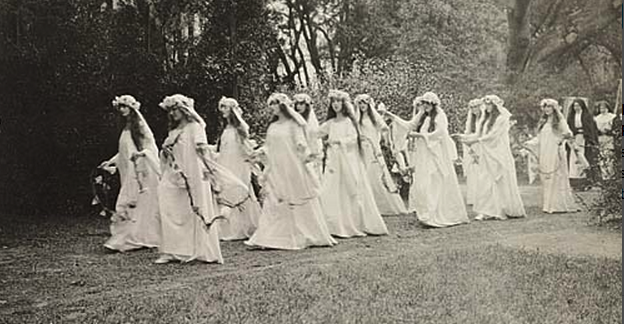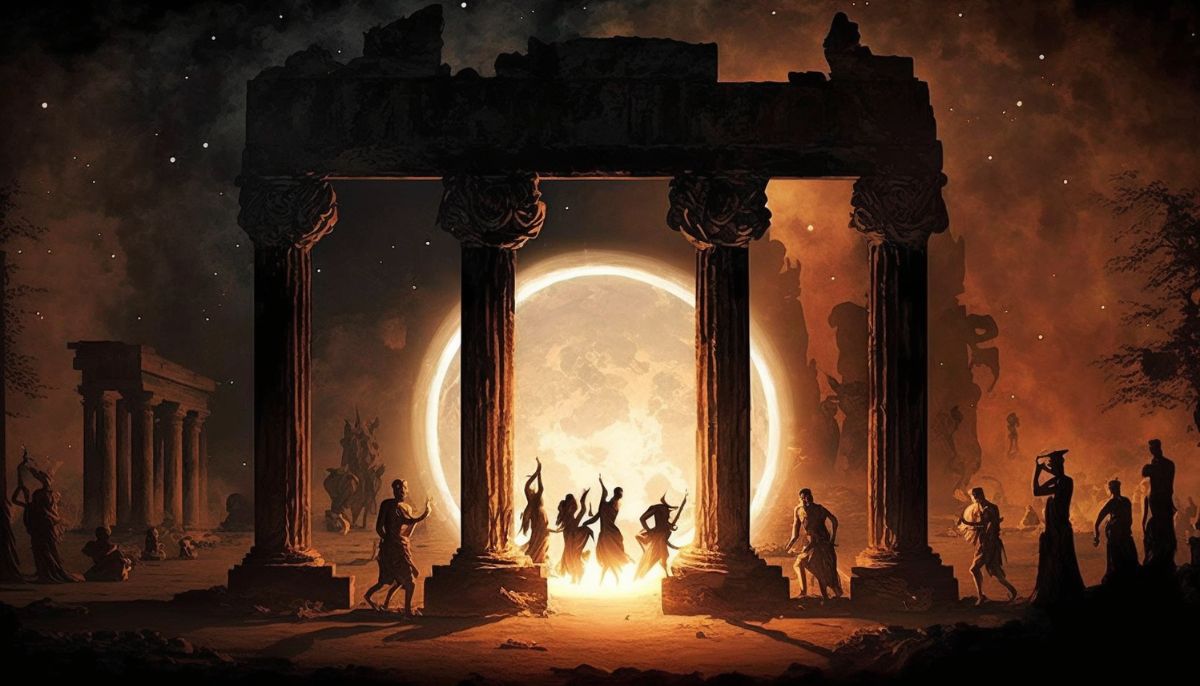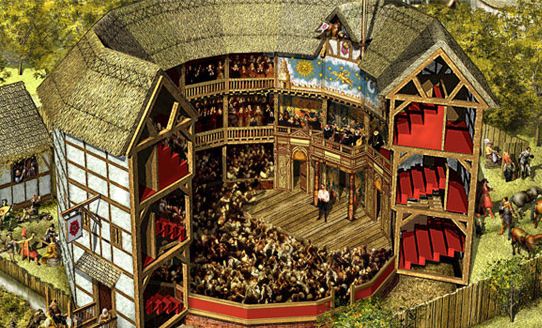Culture
Posted: Sat Nov 23, 2024 7:32 pm
Douglas Mercer
November 23 2024
Culture is not an opinion or an aesthetic or a look or a fad or a trend or a style; it is not the spirit of the times. Culture is an emanation from the race soul of a people, an external expression of that people’s biological endowment. Culture comes from cult or cultic, the ritual practices of a primitive people; now the word cult means a group of people dedicated to behaviors that are considered to be deviant from the main culture; in this reversal is the key: for in its original meaning the cults came from the people and was shared by the people and was common to all.
A great culture can only arise among one race of people who are like no one but themselves; in this greatness the individual is not an “artist” or a “genius” expressing his own idiosyncratic viewpoint but a priest or a seer from whose own soul emerges the total spirit of the people. The two peaks of culture (Greece in the fifth century BC and Elizabethan England) were times when the people had ripened to the extent that native figures emerged who were able to capture and relay all that was growing within the soul of their people.
High Modernism represents the flowering and fomenting of the cult of the lone artist as (probably mad) genius, the alleged towering figure. Joyce with his puzzling word games and his rarefied abstractions, Proust with his unending torrent of self-analysis, Kafka with his claustrophobic myths of unending despair, Picasso with his fractured forms, are considered the prototype: the towering adept. But this is the culture of the coteries and the so-called advanced guard and the salons but this does not represent culture, far from it; this represents decomposition, degeneration and decay.
The 1960s were supposedly a time of culture rejuvenation or rebirth; but the recording artists who populated it had no coherent vision and were given to poetic and lyrical outbursts or paroxysms (which Eliot sneeringly referred to as undisciplined squads of emotion). The period’s two greatest writers, Salinger and Pynchon, are typical; the former given to alienation and private religious ecstasy and the latter given to arcane plots of enormous and pointless erudition combined with slapstick parody; it is significant that these two culture avatars are together most famous for turning their back on the wider culture and becoming fanatical recluses; the culture hero is supposed to enter into the very midst of his people, not live in the moral equivalent of an attic as the crazy aunt or lonely spinster.
Adolf Hitler used to sign his name at Bayreuth as artist and writer as his profession. And so he was. He was a Bohemian at heart but not of the “whole sick crew” variety of Pynchon or the drug addled and faux mysticism type of the Beats and Hippies; no, his paradigm of art was that it had to be of the people, and in a speech lacerating Weimar culture his gravest charge was that the people no longer participated in it. So fragmented culturally was the world that he inherited, so lost in time, that even he found it hard to conjure up artists who could meet the requirements of the New Age that he was creating by separating the people from anything hybrid or mixed or alien. He fell back often on genre painting of landscapes of the 19th century; but Gerdy Troost told him once that even their grandmothers had given up on this type of art; and if National Socialism was to be about anything it was to be future oriented and not a nostalgic looking back. He finally found his pure expression in the sculptures of Breker and Thorak and the gigantic building projects which were slated to comprise Germania. Given time the other arts were to have flourished as well but this valiant attempt at reconstituting a real and whole and people-oriented culture was unfortunately and untimely cut off in mid-stream.
Now of course we have no culture worthy of the name. The spirit of Weimar’s genie has been let out of the bottle and chaos and dark night reign in the houses of publishers, in museums, and on every dial and frequency and every multiplying screen. The Me Decade of doing one’s own things is the mantra and motto and unquestioned watchword now; now we don’t even have artists but cultural technocrats (at best) mining the past like cultural vampires to reprise a motley hodgepodge and pastiche or the real. Now we have niches, and subcultures, and looks, and spaces, and aesthetics; now we have entertainments meant to numb one from the placid and rotten and mindless reality people inhabit often without being aware of it. In this pell-mell milieu certain people can foist a trend; Wilde did it long ago preening as the witty and urbane dandy with the acerbic tone which spawned a never ending wave of meaningless irony; Brando with his black leather jacket did it with the primitive rebel and the false masculine pose and the anti-hero; now the landscape is so diffuse and dispersed that no one can even have this kind of ephemeral power; young girls go to Taylor Swift camp and facsimiles of superheroes inhabit an ersatz Valhalla—when once giants roamed. This of course is not culture, this is not the cultic power, this is a bored and fearful people seeking to be diverted and amused or entertained to keep the monster at bay for a little while longer; this is a people who have lost its way.
The cultural will of our people, however, will not be quelled forever; in places unseen on any current social map it germinates and gestates and gathers its forces; and will come to the fore when the time is right. As for what now passes for a cultural scene it is doomed to pass away; these excremental excrescences which the wider world terms art will end up as fated in the only place such unspeakable horrors belong—the slag heap of history.
***
Notes:
The real potential could be acquired only through creating independent communities. People living separately (both territorially and spiritually) from a wider society. The system can hardly do anything about it. The violent phase described in The Turner Diaries is inevitable at some point. But the resistance must grow organically, not mechanically. It can’t be created instantly from a rag-tag group of formerly mainstream people. The process of mental transformation requires years; and it can be achieved only through separation from decadent society. But when the independent community exists and consists of people who have completely different set of values and lifestyles, there will be no need to urge them for action. The new generation of healthy White people will themselves seek this action—Wolf Stoner
November 23 2024
Culture is not an opinion or an aesthetic or a look or a fad or a trend or a style; it is not the spirit of the times. Culture is an emanation from the race soul of a people, an external expression of that people’s biological endowment. Culture comes from cult or cultic, the ritual practices of a primitive people; now the word cult means a group of people dedicated to behaviors that are considered to be deviant from the main culture; in this reversal is the key: for in its original meaning the cults came from the people and was shared by the people and was common to all.
A great culture can only arise among one race of people who are like no one but themselves; in this greatness the individual is not an “artist” or a “genius” expressing his own idiosyncratic viewpoint but a priest or a seer from whose own soul emerges the total spirit of the people. The two peaks of culture (Greece in the fifth century BC and Elizabethan England) were times when the people had ripened to the extent that native figures emerged who were able to capture and relay all that was growing within the soul of their people.
High Modernism represents the flowering and fomenting of the cult of the lone artist as (probably mad) genius, the alleged towering figure. Joyce with his puzzling word games and his rarefied abstractions, Proust with his unending torrent of self-analysis, Kafka with his claustrophobic myths of unending despair, Picasso with his fractured forms, are considered the prototype: the towering adept. But this is the culture of the coteries and the so-called advanced guard and the salons but this does not represent culture, far from it; this represents decomposition, degeneration and decay.
The 1960s were supposedly a time of culture rejuvenation or rebirth; but the recording artists who populated it had no coherent vision and were given to poetic and lyrical outbursts or paroxysms (which Eliot sneeringly referred to as undisciplined squads of emotion). The period’s two greatest writers, Salinger and Pynchon, are typical; the former given to alienation and private religious ecstasy and the latter given to arcane plots of enormous and pointless erudition combined with slapstick parody; it is significant that these two culture avatars are together most famous for turning their back on the wider culture and becoming fanatical recluses; the culture hero is supposed to enter into the very midst of his people, not live in the moral equivalent of an attic as the crazy aunt or lonely spinster.
Adolf Hitler used to sign his name at Bayreuth as artist and writer as his profession. And so he was. He was a Bohemian at heart but not of the “whole sick crew” variety of Pynchon or the drug addled and faux mysticism type of the Beats and Hippies; no, his paradigm of art was that it had to be of the people, and in a speech lacerating Weimar culture his gravest charge was that the people no longer participated in it. So fragmented culturally was the world that he inherited, so lost in time, that even he found it hard to conjure up artists who could meet the requirements of the New Age that he was creating by separating the people from anything hybrid or mixed or alien. He fell back often on genre painting of landscapes of the 19th century; but Gerdy Troost told him once that even their grandmothers had given up on this type of art; and if National Socialism was to be about anything it was to be future oriented and not a nostalgic looking back. He finally found his pure expression in the sculptures of Breker and Thorak and the gigantic building projects which were slated to comprise Germania. Given time the other arts were to have flourished as well but this valiant attempt at reconstituting a real and whole and people-oriented culture was unfortunately and untimely cut off in mid-stream.
Now of course we have no culture worthy of the name. The spirit of Weimar’s genie has been let out of the bottle and chaos and dark night reign in the houses of publishers, in museums, and on every dial and frequency and every multiplying screen. The Me Decade of doing one’s own things is the mantra and motto and unquestioned watchword now; now we don’t even have artists but cultural technocrats (at best) mining the past like cultural vampires to reprise a motley hodgepodge and pastiche or the real. Now we have niches, and subcultures, and looks, and spaces, and aesthetics; now we have entertainments meant to numb one from the placid and rotten and mindless reality people inhabit often without being aware of it. In this pell-mell milieu certain people can foist a trend; Wilde did it long ago preening as the witty and urbane dandy with the acerbic tone which spawned a never ending wave of meaningless irony; Brando with his black leather jacket did it with the primitive rebel and the false masculine pose and the anti-hero; now the landscape is so diffuse and dispersed that no one can even have this kind of ephemeral power; young girls go to Taylor Swift camp and facsimiles of superheroes inhabit an ersatz Valhalla—when once giants roamed. This of course is not culture, this is not the cultic power, this is a bored and fearful people seeking to be diverted and amused or entertained to keep the monster at bay for a little while longer; this is a people who have lost its way.
The cultural will of our people, however, will not be quelled forever; in places unseen on any current social map it germinates and gestates and gathers its forces; and will come to the fore when the time is right. As for what now passes for a cultural scene it is doomed to pass away; these excremental excrescences which the wider world terms art will end up as fated in the only place such unspeakable horrors belong—the slag heap of history.
***
Notes:
The real potential could be acquired only through creating independent communities. People living separately (both territorially and spiritually) from a wider society. The system can hardly do anything about it. The violent phase described in The Turner Diaries is inevitable at some point. But the resistance must grow organically, not mechanically. It can’t be created instantly from a rag-tag group of formerly mainstream people. The process of mental transformation requires years; and it can be achieved only through separation from decadent society. But when the independent community exists and consists of people who have completely different set of values and lifestyles, there will be no need to urge them for action. The new generation of healthy White people will themselves seek this action—Wolf Stoner






